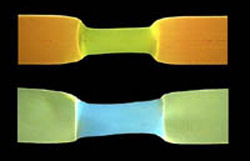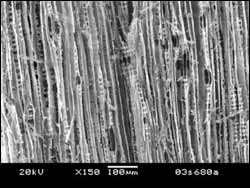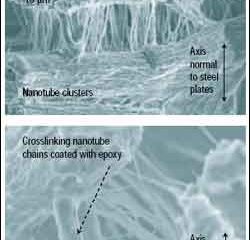Materials Sciences
Materials management deals with the research, development, manufacturing and processing of raw and industrial materials. Key aspects here are biological and medical issues, which play an increasingly important role in this field.
innovations-report offers in-depth articles related to the development and application of materials and the structure and properties of new materials.

Sensor technology can help uncover package tampering
Or tell you when it’s time to reel in that big fish
In a world with an intensified need for security, Case Western Reserve University researchers are developing materials that could make consumers less susceptible to product tampering or failures. Using a mixture of conventional polymers with small amounts of tailored fluorescent dyes, Case researchers have discovered that the dyes function as natural, molecular sensors, creating light-emitting polymer blends that show mechanical s

Fullerenes: optimising surfaces for anti-wear applications
The problem of the tribological behaviour of materials had focussed on either improving friction or prioritising less wear and tear. The target of FOREMOST project (“FOREMOST: fullerene-based opportunities for robust engineering: making optimised surfaces for tribology”) is to achieve both effects simultaneously and, tot his end, the project will be based on the use of inorganic fullerenes (molybdenum bisulphate and bisulphate of wolframite). These new alotropic states of these well-known soli

Want to petrify wood without waiting a few million years? Try this
Pacific Northwest National Laboratory scientists can mineralize wood in record time
California has Silicon Valley. Could a Silicon Forest in Washington be next? A team of materials scientists from Pacific Northwest National Laboratory is on it.
Yongsoon Shin and colleagues at the Department of Energy lab have converted wood to mineral, achieving in days what it takes nature millions of years to do in such places as the Gingko Petrified Forest, an hour up the Columbia Riv

’Bumpy’ glass could lead to self-cleaning windows, slick micromachines
Ohio State University engineers are designing super-slick, water-repellent surfaces that mimic the texture of lotus leaves.
The patent-pending technology could lead to self-cleaning glass, and could also reduce friction between the tiny moving parts inside microdevices.
Scientists have long known that the lotus, or water lily, makes a good model for a water-repellent surface, explained Bharat Bhushan, Ohio Eminent Scholar and the Howard D. Winbigler Professor of mechanical

Sweet and environmentally beneficial discovery: Plastics made from orange peel and a greenhouse gas
A Cornell University research group has made a sweet and environmentally beneficial discovery — how to make plastics from citrus fruits, such as oranges, and carbon dioxide.
In a paper published in a recent issue of the Journal of the American Chemical Society (Sept. 2004), Geoffrey Coates, a Cornell professor of chemistry and chemical biology, and his graduate students Chris Byrne and Scott Allen describe a way to make polymers using limonene oxide and carbon dioxide, with t

Carbon Nanotube "Shock Absorbers" Excel At Dampening Vibration
Researchers at Rensselaer Polytechnic Institute have developed a novel carbon-nanotube-based material that chokes vibration and may have applications for both large and small devices.
In the January 9, 2004, advance online edition of Nature Materials, the researchers describe the new material and demonstrate its usefulness as a filler to enhance traditional vibration-reduction materials.
Conducted by Nikhil Koratkar and colleagues at Rensselaer, the research arose from Ko